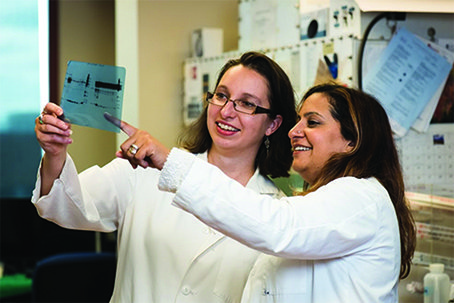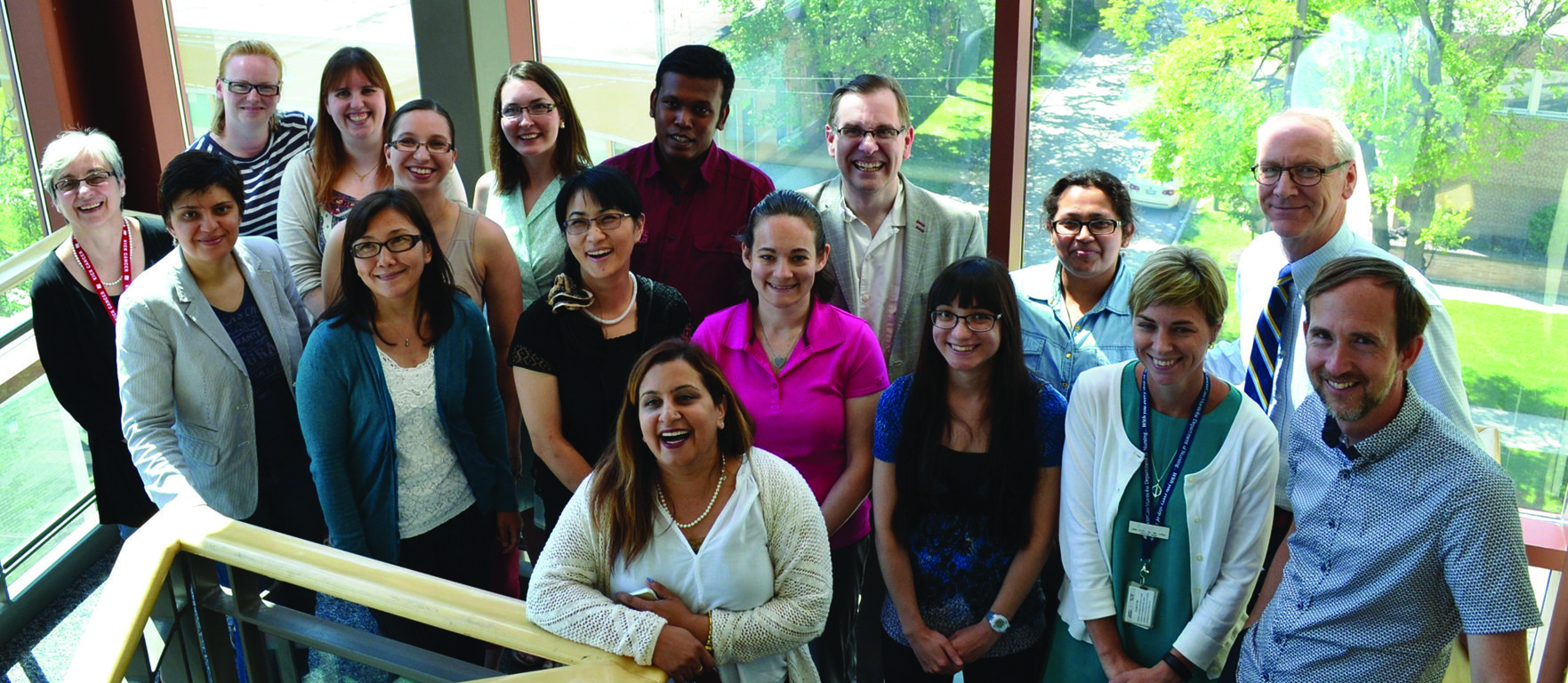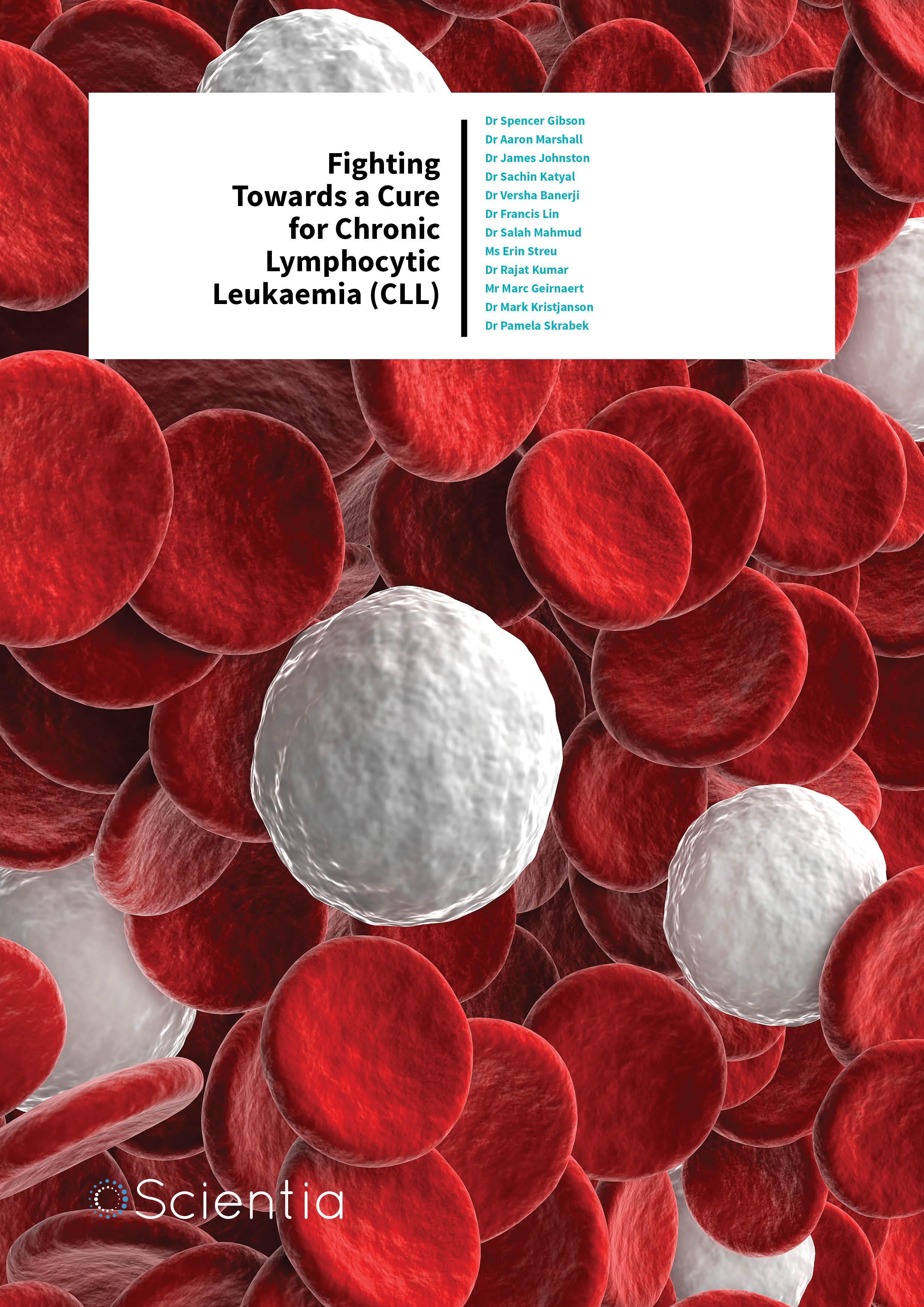Fighting Towards a Cure for Chronic Lymphocytic Leukaemia (CLL)
By developing cutting-edge research projects to improve care and treatment options for individuals with chronic lymphocytic leukaemia (CLL), the CLL Research Cluster at CancerCare Manitoba and the University of Manitoba is leading the charge in the fight against this cancer.
Fighting Canada’s Most Common Blood Cancer
A cancer diagnosis is always difficult to accept, particularly if the cancer is incurable. Such is the case with chronic lymphocytic leukaemia (CLL), the most common type of adult leukaemia in Canada. This cancer is mainly diagnosed in older people, although one-third are less than 65 years. The rates of this cancer are also on the rise due to the ageing population. Although current treatments for this disease are generally effective, relapse does occur and there is an increased risk of developing infections and additional cancers. The prognosis for this disease is highly variable, ranging from a stable condition to rapid disease progression.
CLL is characterised by an accumulation of abnormal B lymphocytes in the blood, bone marrow, spleen and lymph nodes. Normally, lymphocytes function as part of the immune system within the lymph node network and at these sites lymphocytes are nurtured and stimulated to divide and grow. This milieu is termed the microenvironment. The normal function of B lymphocytes is to produce antibodies (immunoglobulins) to fight infections, while T lymphocytes fight infections and can eliminate cancer cells. Like normal lymphocytes, CLL cells are also nurtured and stimulated to grow in the lymph node microenvironment.
As CLL progresses, there can be a progressive drop in blood counts due to the replacement of bone marrow, leading to tiredness, bleeding and risk of infections. In addition, over time the immune system (B and T lymphocytes) loses its effectiveness (called immunosuppression) resulting in an increase in the incidence of infections and second cancers. Dr Spencer Gibson and Dr James Johnston at CancerCare Manitoba have previously published a study demonstrating that skin cancers occur five to ten times more frequently amongst patients with CLL, when compared to people without CLL, and that CLL patients are also two times more likely to develop other types of cancer, such as bowel, breast or prostate cancers. This increased incidence of second cancers is a unique feature of CLL.
‘Understanding the biology behind cancer cells gives us the necessary context to develop therapies that can kill cancerous cells, but not the normal cells that surround the cancer. That is one of the major challenges in cancer therapy today.’

The Research Institute in Oncology and Haematology (RIOH) is a partnership organisation between CancerCare Manitoba (provides all cancer care for the province of Manitoba in Canada), and the University of Manitoba. In an effort to develop cuttingedge treatments and improve the care of people with CLL, Dr Spencer Gibson and his colleagues established the CLL Research Cluster, a patient-centred research program and a joint research venture between the University of Manitoba and CancerCare Manitoba. This cluster comprises an integrated multidisciplinary team conducting research in basic science, clinical care and epidemiology. Two major themes will be addressed by the CLL Research Cluster: first, the development of new therapeutic and management strategies for patients with CLL, and second, to develop a better understanding of the biology of metabolism and migration in CLL. These discoveries can then be translated into improving patient care, survival and quality of life.
Improving Patient Management
The Cluster’s work can be divided into four main projects focused on improving patient management, optimising clinical care, developing novel therapies, targeting CLL metabolism and using innovative technology to investigate CLL cell migration. The projects are designed to integrate research into patient-focused programs with attainable outcomes. The cluster is also committed to an integrated knowledge translation strategy that will shape the process and dissemination of research with the underlying principle of ‘from bedside to bench and back again’. This employs a model where CLL patients are seen in a centralised clinic, patients’ samples are collected and stored in a biobank, provincial health care databases are linked, and innovative technologies are utilised. This combination is unique to Canada and will serve as the foundation for our research.
The first project, Improving Patient Management, is based on the hypothesis that comorbidities – such as high blood pressure, high cholesterol and diabetes – may increase the rate of progression of CLL and impair the immune system, leading to a higher risk of infection and second cancers. Because survival is inversely related to the number of illnesses and second malignancies experienced by a patient, the team aim to identify what factors contribute to these complications, allowing for better monitoring and treatment.

A retrospective study will analyse a decade’s worth of clinical details using CAISIS – an innovative CLL patient database that links clinical features and outcomes with biomarker data from the CLL biobank housed in CancerCare Manitoba. This will be followed by a prospective study in which the physician of every Manitoban CLL patient will be provided with current CLL guidelines to ensure standardised investigations and follow up. The researchers will then analyse which clinical factors are significantly associated with disease progression, infections and second cancers to allow for appropriate monitoring and cancer screening. The changes in the immune system of CLL patients will be assessed using advanced confocal microscopy and flow cytometry technologies. Understanding the specific changes in immune cell populations and functions may also help predict the risk of life-threatening infections or second malignancies. CLL patients will be assessed for major subsets of T lymphocytes, monocytes and natural killer cells, as well as expression of activation markers and immune checkpoint receptors in the patient’s immune system. The association of changes in the immune system with patient outcomes will be determined and this may identify new predictive biomarkers useful for clinical decisions regarding immunisations, infectious disease treatment or monitoring for second malignancies. By uncovering these associations, physicians will be better equipped to monitor high risk patients and educate patients and caregivers.
The second aim of the project explores the factors associated with the referral of CLL patients to specialist care. The team have shown that non-referred CLL patients have a much shorter overall survival than referred patients, and this is particularly true for the elderly who are more likely to receive chemotherapy if referred. Thus, the team aims to determine if there is a difference in the referred and non-referred cohorts regarding clinical features, social factors, illnesses and healthcare utilisation. A retrospective study will explore the factors that decide whether or not patients are referred to the CLL clinic. The outcomes of this decision, including differences in survival, causes of death, quality of life and progression of disease at referral will also be investigated. It will also address differences in costs associated with referred and nonreferred patients. A prospective study will then follow, which compares survival and healthcare utilisation in referred and nonreferred patients, in order to demonstrate the effectiveness of distributing CLL guidelines to physicians. It is hoped that this will influence the survival of non-referred patients through increased education of primary care providers.
Clinical Trials to Improve Patient Care
The second project contains two branches that aim to optimise clinical care. Patients with infections and low antibodies are eligible for immunoglobulin replacement. Traditionally this has been done intravenously (into the blood). The first branch is a provincial pilot program that trains patients how to self-administer subcutaneous immunoglobulins (SCIG) at home, rather than requiring intravenous immunoglobulins in a hospital setting. SCIG has been shown to yield high and stable immunoglobulin levels and is well tolerated with few side effects. The team hypothesises that SCIG will be cost effective in reducing the incidence of infections as well as increasing the quality of life of CLL patients. The approach involves analysing clinical characteristics in order to predict which patients may benefit from SCIG as well as conducting a cost-benefit analysis to track savings to the healthcare system against the resources required to support the SCIG program versus intravenous immunoglobulin treatments.
The second branch of this project is a Phase II clinical trial to test gefitinib as a new cost-effective and specific treatment for CLL patients with ZAP-70 positive CLL. Gefitinib is already a commonly used and well tolerated treatment for lung cancer, but the CLL Research Cluster has shown that it can also kill ZAP-70 positive CLL cells in the laboratory. ZAP-70 is present in half the cases of CLL and is a marker of aggressive disease. This clinical trial will determine whether gefitinib targets CLL cells in patients, without damaging the normal lymphocytes or bone marrow.

In a recent study, the team looked at the effects of siramesine on CLL cells. Siramesine is another drug that has been shown to mediate cell death in other cancers through lysosome membrane permeabilisation (LMP). Lysosomes are cell organelles which contain many different types of enzymes, and are involved in the digestion and removal of waste products from the cell. The team found that CLL cells contained many lysosomes, and were very sensitive to siramesine. Other lymphocytes were not affected by siramesine. Therefore, targeting lysosomes could be a novel therapeutic strategy for CLL patients. The researchers will further determine the clinical relevance of this treatment for CLL patients using the knowledge gained from the clinical trial above.
Innovative Experimental Technology
The third project will investigate novel targets of CLL metabolism. Because cancer cell metabolism has adapted to support high rates of cell proliferation and growth, targeting metabolic pathways in CLL may be effective in preventing and treating disease. Researchers hypothesise that metabolism altering drugs such as metformin and statins will reduce CLL incidence and improve overall survival. First, a population-based study will assess the relative risk of CLL initiation in connection to the duration and dose of metformin or statins use before diagnosis of CLL. Secondly, a prospective study will compare overall and progressionfree survival of patients with and without metformin or statin use after diagnosis. The team expect that metformin and statin use will be associated with a lower incidence of CLL and increased survival in patients affected patients.
This project’s second study will investigate how the drug FK866, an inhibitor of cancer cell metabolism, could be used in combination with other chemotherapeutic drugs. FK866 is known to inhibit NAMPT, an enzyme that promotes B-cell maturation, and is highly expressed in cancer cells. When treated with FK866, CLL cells show a time dependant loss of energy and increased production of oxidative species leading to cell death. However, the mechanisms by which this occurs are not well understood. Therefore, the team aims to understand this process in order to best utilise this drug as part of CLL treatment. They also aim to evaluate if there are additive, synergistic or antagonistic effects of combining FK866 with other chemotherapies.
The final project makes use of innovative technologies to investigate the migration capacity of CLL cells, and determine how this correlates with clinical and prognostic markers. CLL cell migration enables cancer cells to escape from cell death, leading to drug resistance. Novel technologies give researchers the ability to quantitatively assess migration behaviours at a single cell level and assess the impact of novel kinase inhibitor therapeutics on migration behaviour.
CLL cell migration enables cancer cells to escape from cell death and causing drug resistance. A microfluidic chamber developed by the group offers the ability to quantitatively assess migration behaviours at a single cell level. The chamber will also allow for analyses of CLL cells to gain new insights into the role of phosphatidylinositide 3-kinases (PI3Ks) in CLL cell migration. PI3Ks are enzymes involved in certain cellular functions of cancer, such as cell proliferation, migration and survival. The team hypothesises that a distinct branch of the PI3K signalling network mediated by PI(3,4)P2 (an intracellular signalling molecule) controls the migration of CLL cells. They aim to determine the functional impact of PI(3,4)P2 signalling in CLL migration as well as the impact of PI3K inhibitor therapy on migratory behaviours. This is clinically important, as a new therapy targeting PI3K using a drug called Idelalisib is being used to treat patients that have failed front-line therapy. The hope is that this innovative technology will provide new insights into how PI3K targeted drugs could be even more effective.
Mentoring the Researchers of Tomorrow
Running alongside these projects is a novel mentoring programme, in which senior scientists mentor young investigators in their first five years of research. As well as receiving advice on experimental design, support in obtaining grants, and exposure to different research areas, the programme will permit expansion of young investigators’ overall research programmes. Junior scientists will also gain experience in mentoring the next generation of researchers through co-supervision of trainees. Finally, they will be encouraged to present their research at national and international conferences and develop collaborations beyond the research cluster.
Meet the researchers

Dr Spencer Gibson, Head of Cell Biology in the Manitoba Institute in Oncology and Hematology and leader of the CLL Research Cluster, is an expert on the mechanisms of cell survival and cell death, in the context of the mechanisms of action of cancer therapeutics.
E: Spencer.Gibson@umanitoba.ca
Dr Salah Mahmud is a Canada Research Chair in Pharmacoepidemiology and Director of Clinical Trials platform for the Centre for Health Innovation at the University of Manitoba.
E: salah.mahmud@umanitoba.ca
Dr James Johnston is a clinician scientist and the founder of the first dedicated CLL clinic in Canada and focuses his research on developing novel treatments for CLL.
E: jjohnsto@cancercare.mb.ca
Dr Francis Lin is an associate professor in the department of Physics and Astronomy at the University of Manitoba. He is an expert in engineering and has developed a novel microfluidic chamber technology which allows investigations into CLL migration
E: flin@physics.umanitoba.ca
Dr Aaron Marshall is a Canada Research Chair in Molecular Immunology and Professor at the Department of Immunology, whose research program is defining B cell signalling pathways that control cellular migration.
E: Aaron.Marshall@umanitoba.ca
Dr Versha Banerji is a clinician scientist at CancerCare Manitoba and specialises clinically in CLL. Her research focuses on metabolism in CLL and identifying novel targets for treatment.
E: vbanerji1@cancercare.mb.ca
Dr Sachin Katyal is an assistant professor, Department of Pharmacology and Therapeutics, University of Manitoba, with expertise on DNA repair. His research in CLL focuses on understanding the role of DNA repair in drug resistance and developing and focuses on clinically relevant research into CLL biology and drug resistance as well as the mechanisms of action of new therapeutics.
E: Sachin.Katyal@umanitoba.ca
Ms Erin Streu is an Advanced Practice nurse, whose research focuses on developing and implementing interventions that improve overall patient quality of life, particularly with regard to the infectious complications of immunosuppression in CLL.
E: estreu@cancercare.mb.ca
Dr Pamela Skrabek is a haematologist and head of the Lymphoma group. Her interest is in the epidemiology of lymphomas and CLL, and in the utility of immunisation in CLL.
E: pskrabek@cancercare.mb.ca
Dr Rajat Kumar is a haematologist who is involved in marrow stem cell transplantation and the treatment of myelodysplasia. His research interests focus on pharmacoeconomics.
E: rkumar@cancercare.mb.ca
Mr Marc Geirnaert, Director of Provincial Oncology Drug Program at CancerCare Manitoba, and plays an integral role in the development of therapeutic guidelines in CLL.
E: mgeirnaert@cancercare.mb.ca
Dr Mark Kristjanson is an Associate Professor in the Department of Family Medicine, University of Manitoba. He is the Head of Primary Care at CancerCare Manitoba, playing a key role in the running of Urgent Care. His educational activities involve the education of family physicians regarding CLL and other malignancies.
E: Mark.Kristjanson@cancercare.mb.ca



